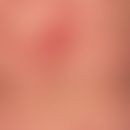HistoryThis section has been translated automatically.
Shankmann, 1946
DefinitionThis section has been translated automatically.
Rare rickettsiosis caused by Rickettsia acarii, transmitted by mouse and rat mites.
You might also be interested in
PathogenThis section has been translated automatically.
Rickettsia acarii is a member of the spotted fever group, which also includes Rickettsia rickettsii, the causative agent of Rocky Mountain spotted fever.
Occurrence/EpidemiologyThis section has been translated automatically.
Smaller endemics have developed in recent years, especially in New York. A total of about 800 cases have been reported by 2010.
LocalizationThis section has been translated automatically.
The lower legs, ankles, forearms and back are mainly affected.
ClinicThis section has been translated automatically.
Start with headache (89% of patients), myalgia (39%) and high fever (100%) between 38 and 40 °C. A papulovesicle develops at the site of transmission itself. In addition, a regional lymphadenopathy develops, and shortly afterwards, on the 3rd to 5th day of fever, a maculopapular or vesicular or varicelliform exanthema. Less frequent are lymphadenopathies, GI disorders (28%), and arthralgias (28%).
LaboratoryThis section has been translated automatically.
Mild leukopenia and thrombopenia and, more rarely, leukocytosis are present. The SPA is clearly elevated (1st hour > 90). Liver metabolism disorders are rarely present.
HistologyThis section has been translated automatically.
Early lesions show superficial and deep perivascular dermatitis, consisting of lymphocytes, macrophages and occasionally neutrophilic granulocytes. Edema in the papillary body varies in severity. No evidence of leukocytoclastic vasculitis. With appropriate anti-Rickettsia antibodies Rickettsia can be detected in monocular cells of the infiltrate.
Differential diagnosisThis section has been translated automatically.
Complication(s)(associated diseasesThis section has been translated automatically.
Scarring in ulcerated efflorescences.
TherapyThis section has been translated automatically.
S.u. Rickettsialpox. Therapy with Doxycyclin 100 mg/day p.o. for 7 days.
Progression/forecastThis section has been translated automatically.
Favorable; temperatures normalize within 24-48 hours after administration of the antibiotic.
LiteratureThis section has been translated automatically.
- Kass EM et al (1994) Rickettsialpox in a New York City hospital, 1980 to 1989 New Eng J Med 331: 1612-1617
- Koss T et al (2003) Increased detection of rickettsialpox in a New York City hospitasl following the anthrax outbreak of 2001 Arch Dermatol 139: 1545-1552
- Paddock CD et al (2003) Rickettsialpox in New York City: a persistent urban zoonosis. Ann N Y Acad Sci 990: 36-44
- Sanders S et al (2003) Rickettsialpox in a patient with HIV infection. J Am Acad Dermatol 48: 286-289
- Shankmann B (1946) Report of an outbreak of endemic febrile illness, not yet identified, occurring in New York City. NY State Med J 46: 2156-2159
Disclaimer
Please ask your physician for a reliable diagnosis. This website is only meant as a reference.




